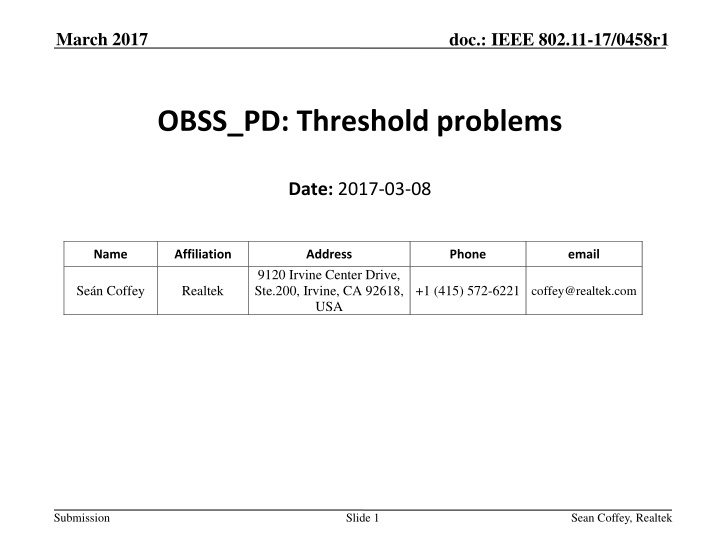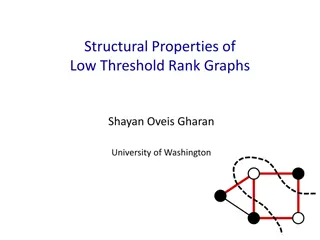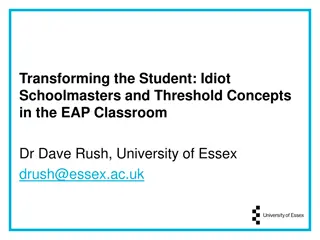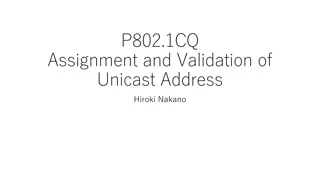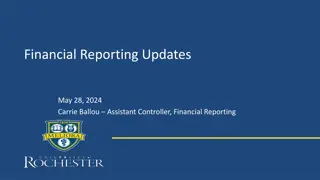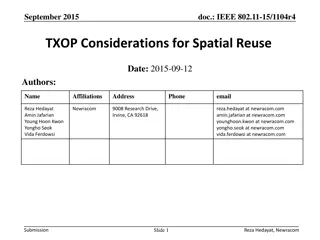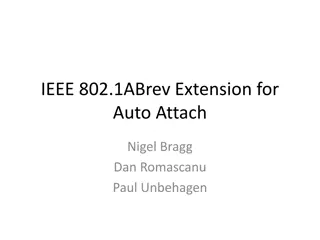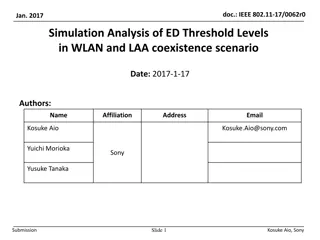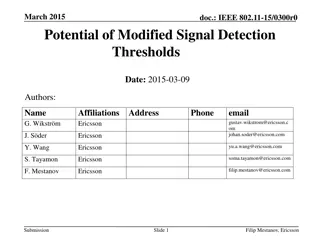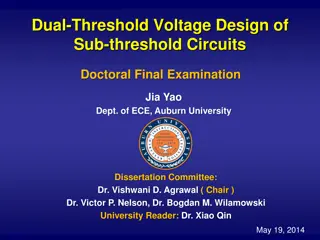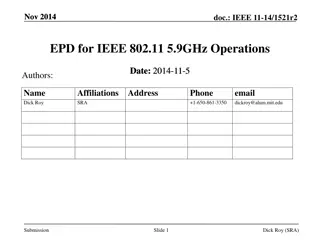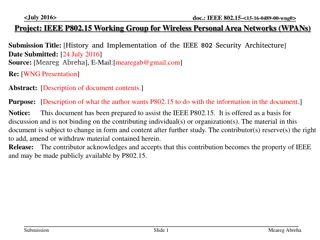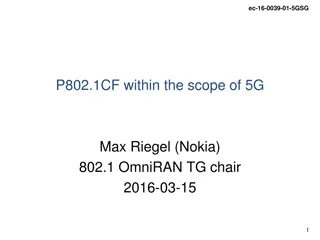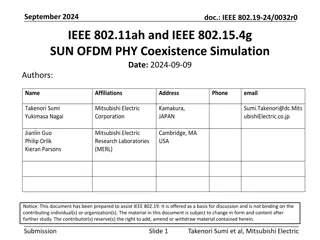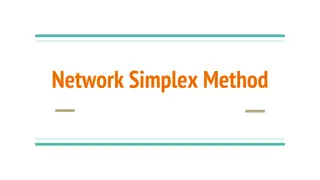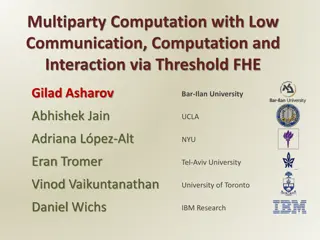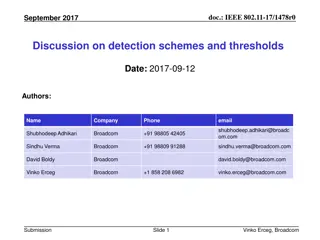Threshold Problems in IEEE 802.11-17 Network: Addressing Efficiency Concerns
This presentation delves into the challenges posed by using the OBSS_PD threshold rule in IEEE 802.11-17 networks. It discusses the potential impact on system efficiency, proposes solutions for optimization, and explores the consequences of adjusting OBSS_PD thresholds. The slides analyze the trade-offs between increasing successful transmissions, reducing interference, and enhancing spatial reuse principles.
Download Presentation

Please find below an Image/Link to download the presentation.
The content on the website is provided AS IS for your information and personal use only. It may not be sold, licensed, or shared on other websites without obtaining consent from the author.If you encounter any issues during the download, it is possible that the publisher has removed the file from their server.
You are allowed to download the files provided on this website for personal or commercial use, subject to the condition that they are used lawfully. All files are the property of their respective owners.
The content on the website is provided AS IS for your information and personal use only. It may not be sold, licensed, or shared on other websites without obtaining consent from the author.
E N D
Presentation Transcript
March 2017 doc.: IEEE 802.11-17/0458r1 OBSS_PD: Threshold problems Date: 2017-03-08 Name Affiliation Address Phone email 9120 Irvine Center Drive, Ste.200, Irvine, CA 92618, USA Se n Coffey Realtek +1 (415) 572-6221 coffey@realtek.com Submission Slide 1 Sean Coffey, Realtek
March 2017 doc.: IEEE 802.11-17/0458r1 Abstract OBSS_PD, in the form described in D1.0, implements the so- called proportional rule , with an OBSS_PD_min value of -82 dBm. The rule, as described in D1.0, may lower system efficiency in many scenarios, and it s at the very least questionable whether it is an overall net positive. This presentation outlines the rule and its effects (positive and negative) and proposes fixes that will make it work better. CIDs addressed: 6768; partially relevant to CIDs referencing OBSS_PD thresholds: 3198, 3199, 3200, 5204, 5205, 5207, 5208, 5484, 5489, 5494, 5495, 5496, 5497, 5499, 5500, 5501, 5502, 5503, 5690, 5691, 5870, 7122, 7123, 7129, 7406, 7612, 8073, 8104, 8232, 8239, 9315,9540, 9944, 9946, 9947, 10031, 10032, 7125, 3197, 5689, 9541, 3222, 3196, 6025, 7823, 8233 Submission Slide 2 Sean Coffey, Realtek
March 2017 doc.: IEEE 802.11-17/0458r1 Spatial Reuse first principles, 1/6 (Consider unmanaged deployments only) The basic goal of spatial reuse: A C E B D F Increase number of successful transmissions: (1) Add new transmissions and/or (2) Turn failing transmissions successful Increase OBSS_PD threshold Reduce Tx power Submission Slide 3 Sean Coffey, Realtek
Slide 4 March 2017 doc.: IEEE 802.11-17/0458r1 OBSS-PD SR Note that OBSS-PD SR Allows more transmission in the red shaded area which causes interference to RX. Reduction in SR TX power leads to reduction of interference (orange shaded area) Note increase of interference statistically. Denser operation allows Increased interference from SR STA due to OBSS_PD SR OBSS_PD level > -82dBm CCA=-82dBm Reduced interference from SR STA due to reduced TX power RX TX Based on and adapted from [1, 3] and similar presentations Submission Sean Coffey, Realtek
March 2017 doc.: IEEE 802.11-17/0458r1 Spatial Reuse first principles, 2/6 A specific case: Can C lower Tx power enough to permit A B to succeed? A C It s possible. But it s usually very difficult. Effective noise floor @ B (with no interference cf. next slide) is -95 dBm B may be closer to C or farther away; on average about same distance C interference @ B under proportional rule -82 dBm 13 dB too high! B D (Assume 20 MHz channels, 6 dB noise figure) Submission Slide 5 Sean Coffey, Realtek
March 2017 doc.: IEEE 802.11-17/0458r1 Spatial Reuse first principles, 3/7 A specific case, contd. & refined: C has lowered Tx power using proportional rule C @ A = -82 dBm We will do a random drop of B inside this circle A uses conservative MCS (interference, stability): A B succeeds if C @ B is -88 dBm (7 dB SINR margin) |CB| 1.48 |CA| 73% probability that A B fails -93 dBm (2 dB margin): 100% -82 dBm (13 dB margin): 40% Random drop of B in circle -88 dBm A C -82 dBm FAIL A = victim Tx B = victim Rx C = interferer Tx Submission Slide 6 Sean Coffey, Realtek
March 2017 doc.: IEEE 802.11-17/0458r1 Spatial Reuse first principles, 4/7 A specific case, recap: Can C lower Tx power enough to permit A B to succeed? A C We start out with a 13 dB gap we need to make up If there s a higher effective noise floor due to interference, and if we add a generous MCS margin, can make up some of that gap Lowers A B MCS M i g h t work (Need to avoid a net loss) B D (Assume 20 MHz channels, 6 dB noise figure) Submission Slide 7 Sean Coffey, Realtek
March 2017 doc.: IEEE 802.11-17/0458r1 The -82 dBm CCA threshold 1/4 Why is the baseline CCA Threshold = -82 dBm? Why not -95 dBm or some other lower value? Dev 1 Dev 3 Because there s another constraint: Device 3 must decode the 6 Mbps L-SIG from device 1, to read the duration and set the NAV CCA Threshold should be adequate to permit 6 Mbps L-SIG to be decoded (most of the time) by all devices Dev 2 Submission Slide 8 Sean Coffey, Realtek
March 2017 doc.: IEEE 802.11-17/0458r1 The -82 dBm CCA threshold 2/4 This is exactly where the -82 dBm CCA threshold comes from: CCA sensitivity The start of a valid OFDM transmission at a receive level equal to or greater than the minimum 6 Mbit/s sensitivity (-82 dBm) shall cause CCA to indicate busy with a probability >90% within 4 s. 802.11a-1999 (R2003), section 17.3.10.5 Submission Slide 9 Sean Coffey, Realtek
March 2017 doc.: IEEE 802.11-17/0458r1 The -82 dBm CCA threshold 3/4 and huge margins were built in: Receiver minimum input level sensitivity The packet error rate (PER) shall be less than 10% at a PSDU length of 1000 bytes for rate-dependent input levels shall be the numbers listed in Table 91 or less. The minimum input levels are measured at the antenna connector (NF of 10 dB and 5 dB implementation margins are assumed). 802.11a-1999 (R2003), section 17.3.10.1 Submission Slide 10 Sean Coffey, Realtek
March 2017 doc.: IEEE 802.11-17/0458r1 The -82 dBm CCA threshold 4/4 Full calculation that led to -82 dBm: -102.1 dBm1 + 4.7 dB2 + 10 dB3 + 5 dB4 = -82.4 dBm, -82 dBm5 1. 2. 3. 4. 5. Noise floor for 16.25 MHz Operating point for 6 Mbps 1,000 byte packets, 10% FER, from the simulations used Noise figure Implementation margin See docs. IEEE 802.11-99/023, Comments on P802.11a draft , M. Morikura (NTT), January 1999 (giving curves, -88 dBm for first three combined), and IEEE 802.11- 99/016, Comments received on 802.11a in Letter Ballot 16 , January 9, 1999, pp. 7-8 (-87.4 dBm for first three, proposing -82 dBm) Corresponding calculation if specified today: -102.1 dBm + 4 dB(2) + 6 dB(3) = -92.1 dBm, -92 dBm Submission Slide 11 Sean Coffey, Realtek
March 2017 doc.: IEEE 802.11-17/0458r1 The CCA threshold, if rederived today Additional adjustments required Use SNR needed to decode the L-SIG (4 bytes), instead of 1,000 bytes Perhaps 3-4 dB lower? Use SNR needed to decode L-SIG with frequency-selective fading rather than AWGN (as 802.11a did, in effect) E.g. channel model D, but conditioned on given RSSI Perhaps 4-5 dB higher? Net result (rough estimates), in the range (-92 dBm -89 dBm) for 1 SS device; in the range (-95 dBm -92 dBm) for 2 SS devices Most 2 SS devices today should be able to decode the L-SIG in practice with RSSI of -92 dBm or higher, most of the time - Submission Slide 12 Sean Coffey, Realtek
March 2017 doc.: IEEE 802.11-17/0458r1 CCA threshold, summary -82 dBm So what s this? It s the level at which devices have to stop pretending they can t hear L-SIGs. Because it was not credible (in 1999!) that any device would not have been able to decode at this level. This accounts for 10 dB of our 13 dB gap . Every 2 SS device should be able to decode most L-SIGs here close to -95 dBm from here proportional rule starts to make sense -92 dBm -95 dBm Desirable limit of interference Submission Slide 13 Sean Coffey, Realtek
March 2017 doc.: IEEE 802.11-17/0458r1 Spatial Reuse first principles, 5/7 Effect of the mismatch: C has lowered Tx power using proportional rule plus an additional 10 dB C @ A now = -92 dBm Same conditions as before: We will do a random drop of B inside this circle A uses conservative MCS: A B succeeds if C @ B is -88 dBm (7 dB SINR margin) |CB| now 0.77 |CA| 24% probability that A B fails (was 73% before) Random drop of B in circle -88 dBm A C -92 dBm FAIL A = victim Tx B = victim Rx C = interferer Tx Submission Slide 14 Sean Coffey, Realtek
Slide 15 March 2017 doc.: IEEE 802.11-17/0458r1 OBSS-PD SR, 2/2 Note that OBSS-PD SR Allows more transmission in the red shaded area which causes interference to RX. Reduction in SR TX power leads to reduction of interference (orange shaded area) Note increase of interference statistically. Denser operation allows Increased interference from SR STA due to OBSS_PD SR OBSS_PD level > -82dBm CCA=-82dBm Reduced interference from SR STA due to reduced TX power RX TX Based on and adapted from [1, 3] and similar presentations Submission Sean Coffey, Realtek
March 2017 doc.: IEEE 802.11-17/0458r1 Spatial Reuse first principles, 6/7 (Consider unmanaged deployments only) The other case: A C E B D F Transmit power control can only help reuse Maybe increased OBSS_PD threshold is the incentive to use TPC also? Devices lose when they re B but statistically gain when they re F Submission Slide 16 Sean Coffey, Realtek
March 2017 doc.: IEEE 802.11-17/0458r1 Spatial Reuse first principles 7/7 OBSS_PD as a tradeoff more transmit opportunities as incentive to lower transmit power Well maybe. (It seems a bit hazy. Are we sure this is a net gain?) Also note that: This can only be a factor when we have 3 or more OBSSs no possible gain from this factor when we have just 2 OBSSs The OBSS_PD rule is dynamic: why would the interferer reduce its transmit power when it does not encounter neighbors it otherwise would defer to? I.e., interferer adapts to its neighboring traffic; if no need to increase OBSS_PD threshold in recent time, why lower transmit power? When increased OBSS_PD threshold is used, we are with high probability killing the frame we aretransmitting over Submission Slide 17 Sean Coffey, Realtek
March 2017 doc.: IEEE 802.11-17/0458r1 A way to fix this Involve the victim AP in the decision loop! This is a very complicated feature to specify and analyze, featuring multiple BSSs (possibly multiple OBSSs), traffic modelling, projections of future deployments and many topics that we have always left out of the standardization process (rate selection & shifting algorithms, fragmentation policy, latency and power management, interference assessment and mitigation, etc.) The one unifying principle: if the victim AP is happy, everyone is happy All we need to do is to provide a way for the victim AP to permit OBSS_PD over frames in its BSS (or rather, to disallow if the default is to permit), with just enough incentive for permission to be granted Submission Slide 18 Sean Coffey, Realtek
March 2017 doc.: IEEE 802.11-17/0458r1 A sample approach Assign bit combination in HE-SIG-A field to turn off non-SRG OBSS_PD, i.e., *other* STAs may not use non-SRG OBSS_PD over that frame STAs may only use the appropriate bit combination if given permission by the AP to which they re associated Permission can come from BSS-wide policy bits set in the beacon (and changeable dynamically). Permission can come from an individually addressed frame from the AP, giving permission. Such permission, even if granted, only lasts for N successful frames transmitted by that STA. STAs may only use non-SRG OBSS_PD themselves if they have permitted it for the last N frames transmitted by that STA Submission Slide 19 Sean Coffey, Realtek
March 2017 doc.: IEEE 802.11-17/0458r1 Straw poll (informational) Do you agree to modify the OBSS_PD mechanism to allow for victim transmitters to disable use by other devices of non-SRG OBSS_PD for the frame in progress, according to the approach described on slide 18 of this document? Y N A Submission Slide 20 Sean Coffey, Realtek
March 2017 doc.: IEEE 802.11-17/0458r1 References [1] IEEE doc. 11/14-0637r0, Spatial Reuse and Coexistence with Legacy Devices , J. Wang (MediaTek) et al., May 2014 [2] IEEE doc. 11/14-0872r0, A Protocol Framework for Dynamic CCA, S. Coffey (Realtek) et al., July 2014 [3] IEEE doc. 11/15-1069r3, Adaptive CCA and TPC , J. Wang (MediaTek) et al., September 2015 [4] IEEE doc. 11/15-1082r1, Analysis of BSS and ESS Structure During Concurrent SR Transmissions , C. Lukaszewski (Aruba Networks), September 2015 [5] IEEE doc. 11/15-1083r3, Cost/Benefit Analysis of SR Techniques (a.k.a. Grand Unified Theory of Spatial Reuse) , C. Lukaszewski, L. Li (Aruba Networks), September 2015 Submission Slide 21 Sean Coffey, Realtek
